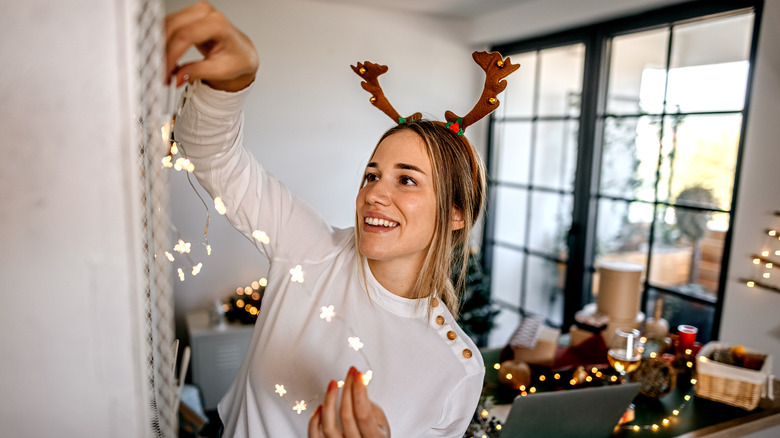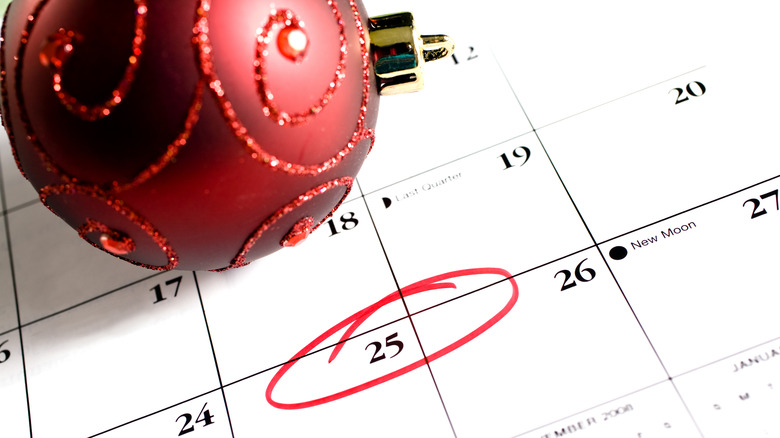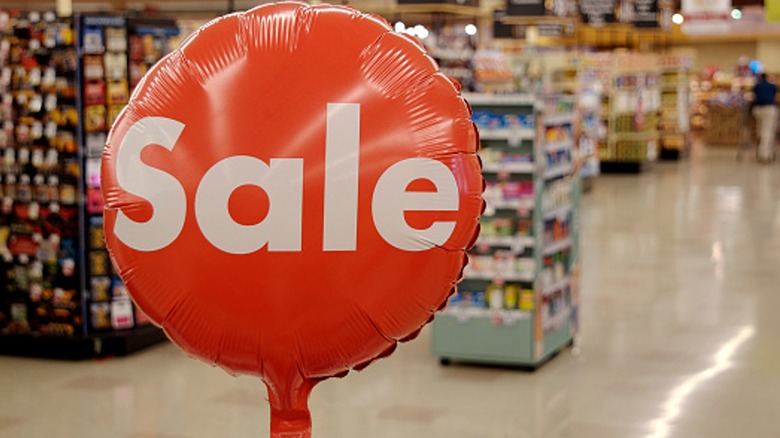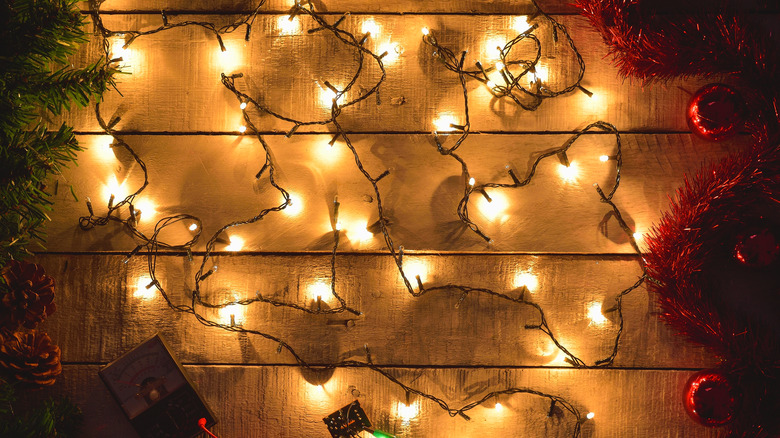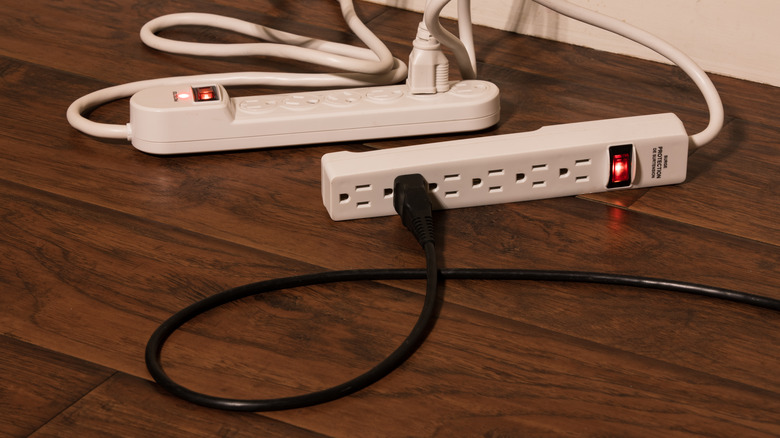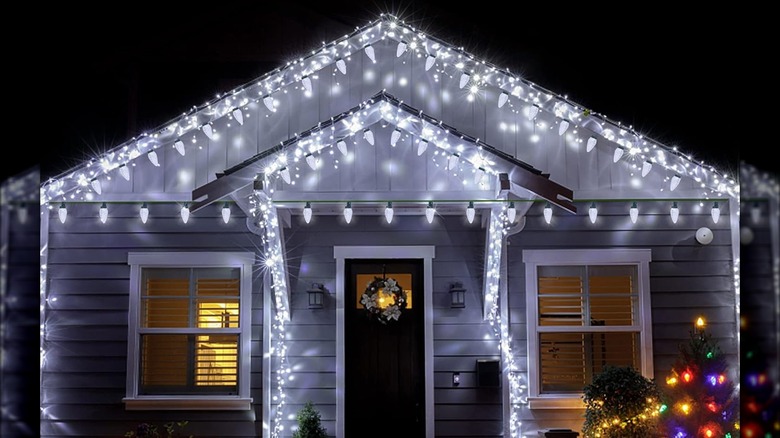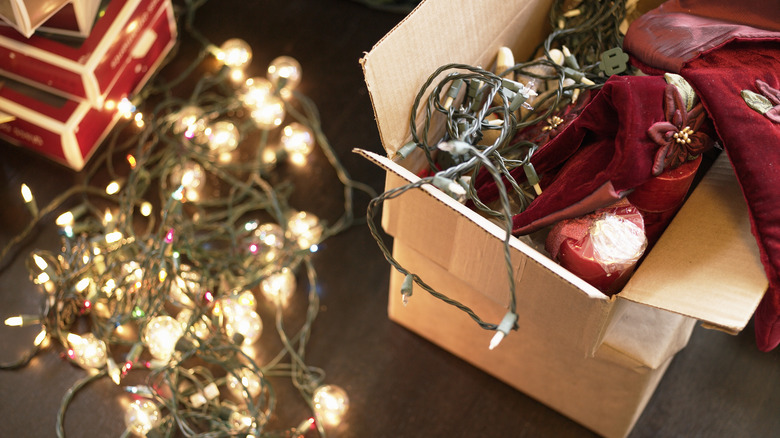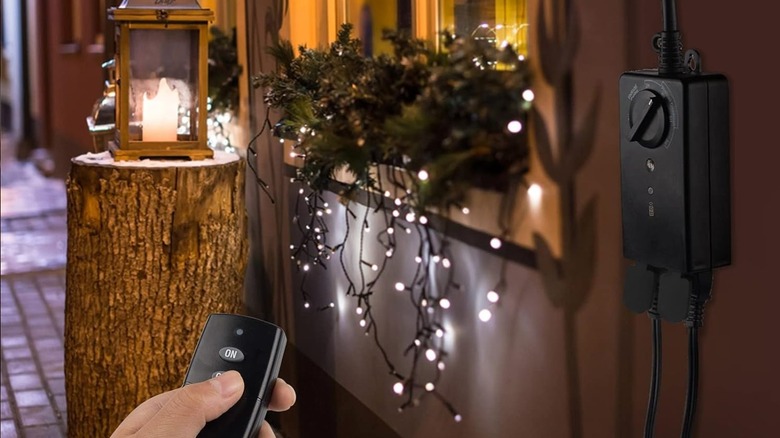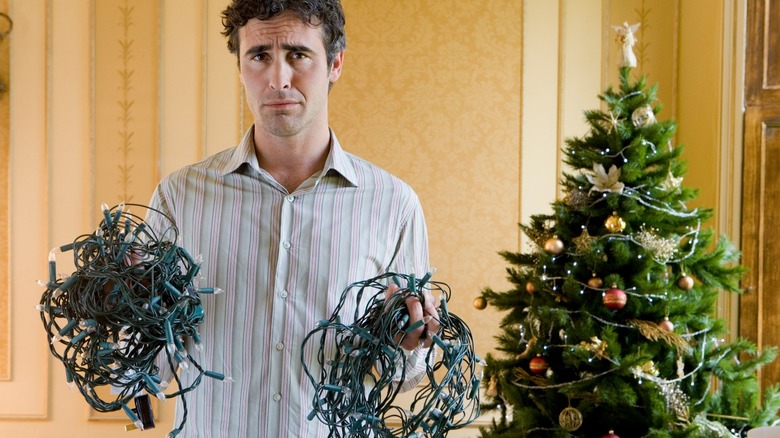11 Common Mistakes Everyone Makes When Buying Christmas Lights
We may receive a commission on purchases made from links.
It may seem hard to believe, but the holidays are almost upon us once again. Purchasing some new Christmas lights is a great way to get you and your home into the holiday spirit. Hanging lights from your gutters, wrapping them around bushes, and of course, using them to decorate the Christmas tree, can help to transform your home into a beautiful winter wonderland. However, achieving that winter wonderland may not be as simple as you might think.
Buying Christmas lights might not seem overly complicated. Yet, there are several common mistakes that people make when completing this holiday shopping task. And, these mistakes can have a serious impact on your Christmas displays. Beyond leaving you with a less-than-appealing finished product, you could also end up wasting money on energy costs, increasing your workload unnecessarily, creating a fire hazard, and more. Read on to ensure your holiday light displays go up without a hitch.
Waiting until the last minute to place an order
There are times when procrastinating can really trip you up, and shopping for Christmas lights is one of those times. Waiting until the last minute to place an order has the potential to spell disaster in so many different ways, especially if you're super serious about your holiday display. First of all, many retailers may sell out of certain styles of lights, leaving you with more limited options. This may prevent you from decorating to match your vision, leaving you dissatisfied with your results.
Shipping delays can also pose a more serious problem if you wait too long to place your order. As we get closer to Christmas, there are more and more packages being shipped, which can lead to increased wait times. There is also a higher risk of severe weather in many parts of the country, which can cause additional delays. You'll also have no room for error if you place an order at the absolute last minute. What will you do if you don't have enough lights to decorate your entire house? What if the company accidentally sends the wrong bulb color or style? There simply won't be sufficient time to get what you need in time. Avoid all of these potential problems by placing your order several weeks before you plan to decorate.
Missing out on Christmas light sales
Instead of ordering only a few weeks before you'll need the lights, an even better idea is to order far enough in advance that you can take advantage of major sales. The best time to purchase Christmas lights for the greatest discount is right after the holiday season. Retailers will be looking to clear seasonal merchandise to make way for new products, so you're likely to get a better deal on any lights that are leftover.
If you didn't get a chance to shop the end-of-season sales after last Christmas, all hope is not lost. Look for other sales, such as those run on Black Friday, Cyber Monday, or Prime Day. If you can take a minute from sunning by the pool or beach during the summer, many companies may also run "Christmas in July" sales towards the end of the month. Purchasing Christmas lights will be an investment, but there is no reason you need to pay full price.
Spending more than the budget allows
It is easy to go overboard when it comes to buying Christmas lights. Before you start shopping, be sure to set a budget and try to stick to it. Christmas lights can give your home a very festive feel, but they'll only be up for a short time, and you don't want to end up spending more than you can afford.
The price of Christmas lights can vary greatly, depending on the types of lights you want to purchase, how many strands you'll need, and where you are buying them from. As an example, some LED light strands can cost as little as $6, while others can cost $50 or more. If you want to purchase commercial-grade lights, expect to spend even more — between $20 and $200. Keep the bottom line in mind, but also think about how long each option is likely to last and how much you'll be spending to replace things in the future. Remember, you don't have to purchase everything all at once. You can build on your display over time if you don't have the budget to do it all at once. Consider starting with your roofline your first year, then add additional lights for trees, bushes, and other lawn decorations in subsequent years.
Choosing incandescent bulbs over LED lights
While incandescent bulbs have a lower purchase price than LED bulbs, buying them may be a mistake that you'll come to regret. There are several reasons why LED lights are superior to their incandescent counterparts. First, they are much more energy-efficient. They use about 75% less energy than incandescent options, which means you don't have to worry about your December energy bill skyrocketing thanks to all the holiday lights. They also have a much longer lifespan and can last up to 25 times longer than the old-school option. This means you'll end up shelling out less over the years for your holiday decor.
You'll also notice that there are several more color and shape options when it comes to purchasing LED lights. They can help you create a more vibrant display with their bright colors — though a few people may find them to be a bit too bright if they prefer the warmer glow of incandescent bulbs.
Not keeping safety in mind
Christmas lights have the ability to transform a house by giving it a beautiful glow during the holiday season. However, if proper safety measures aren't followed, you're taking the risk of starting a different type of glow — one caused by a fire. To protect your home from a tragedy, there are a few simple steps you should take when planning out your holiday light displays. First, only purchase lights that have been certified by the Underwriters Laboratory (UL) or other OSHA-certified organizations. LED lights also pose a lower risk of fire than incandescent bulbs because they do not get as hot, so that is another reason to consider purchasing them instead.
If you need any extension cords for your display, there are more safety considerations to keep in mind when purchasing them. Only use cords made specifically for the outdoors when decorating your home's exterior. These models are designed to resist water, dipping changes, and more, making them a much safer choice. So don't grab a spare one you use indoors to light up your display! Keep in mind that you should also never plug one extension cord into another, so you'll want to measure to determine the appropriate length that you'll need to buy instead of trying to piece multiple shorter wires together. You'll also want to avoid overloading any of your circuits, so check the ratings for each type of light you purchase to see how many strands can safely be connected together.
Not measuring before making a purchase
Don't make the mistake of not measuring before purchasing your Christmas lights. One of two things is likely to happen: You're going to end up buying more lights than you need, or you're not going to buy enough to complete your display. While you might be able to return extra lights, not having enough can prove to be a big problem. No one wants to run out of lights, leaving their roofline only partially covered or only half of the bushes in the yard lit up.
To make sure you don't have to deal with the stress of scrambling to get more lights that match what you already purchased, be proactive and calculate just what you'll need to get the job done right in the first place. Measure all the surfaces where you want to string lights — these may include the roofline, doorways, windows, deck railings, and more. Then, when purchasing lights for these areas, keep in mind that you'll want to pay attention to the lighted length of the strand, not the overall length (which is about 1 foot longer than what actually has lights on it).
Don't forget also to calculate how many lights you'll need to illuminate the trees or bushes on your property. You'll be wrapping the lights around these landscaping elements, so you won't be able to simply measure them with a tape measure. However, as a general rule, you should expect to need about 32 feet to cover each foot and a half of a tree, which means you'll need around five or six strands to light an eight-foot tree. Bushes and hedges should each need either one or two net lights.
Not creating a plan before shopping for lights
We just discussed the importance of measuring before making any purchases, but there is something else you should also do before adding anything to a shopping cart, whether online or in a store: Plan out exactly what you want your display to look like. Where will you be hanging lights? Are you going to add any hanging decorations, such as a lighted snowflake or candy canes? Do you want any LED lawn decorations or inflatables to go with your overall theme?
Thinking about all of these questions can help you ensure that you create a cohesive look. Sketch out your house and how you plan to set everything up. Doing so can help you decide whether you want larger and more colorful C7 or C9 bulbs for your roof or if you'd prefer the look of white icicle lights. Taking the time to really plan out what you want can save you from the "I wish I would have..." after you've purchased and hung the lights. You're much more likely to be happy with the finished design this way.
Overlooking the benefits of commercial-grade lights
Commercial-grade Christmas lights will require a greater upfront investment. However, once you learn more about the benefits of these products, you might decide that the initial investment is worth it. First of all, commercial-quality lights offer greater durability than standard models that you can purchase through major retailers. The lights are better able to resist damage than their less expensive counterparts. These options are also waterproof and are better able to stand up to the elements. Because of their greater strength and durability, you can expect commercial-grade lights to last longer. This can bring the average yearly cost down significantly.
When you shop from retailers that sell commercial-quality options, you're also likely to find greater customization options. You can choose from different connector options, color schemes, and more to create the display of your dreams. With these higher-quality products, you'll have less to worry about each season about whether your lights from the previous year will still work.
Not planning ahead and thinking about storage options
When you're shopping for Christmas lights, your focus is probably on getting them up and enjoying the display you create. You might not be thinking about how you're going to store all of those lights once the season is over and they need to come down. Failing to keep this in mind before you purchase the lights could turn out to be a big mistake. You want to have a plan in place for how you'll stash your decorations so you don't find yourself in a tight spot in a few weeks.
Christmas lights can take up a lot of space if they're not properly stored, and if you're buying a lot to cover your roofline, trees, and bushes, they're going to take up even more space. Consider adding a few extension cord reels or wraps to your shopping cart. They'll make it possible to wind up the strings of lights for more compact storage. Plus, when you go to hang the bulbs up the next year, you won't have to spend hours untangling everything. If you don't want to spend any additional money, you can also keep light strands from getting tangled by wrapping them around a hanger or a piece of cardboard.
Not adding a timer to the shopping cart
There's one other thing you'll want to be sure to add to your shopping cart to really get the most out of your holiday light displays: a timer. Timers can really simplify your life. Instead of taking the time to go outside every evening and plug your lights in (and go back outside later to unplug them), you can set the timer so that they turn on and off automatically. This will also ensure that your house is lit up if you're out to dinner or visiting friends at a holiday party. Moreover, purchasing a timer can minimize the risk of a house fire since the lights won't accidentally get left on for too long.
There are a few different types of timers that you can choose from. The first is a digital timer. While these may be a bit more expensive, they'll be easier to program using the on-screen options than some manual options. Mechanical timers aren't very difficult to use either. You just need to set the dial to indicate when you want the lights to turn on and off and plug the lights into the outlets on the panel. You can also find photocell timers that will automatically turn on the lights when it becomes dark outside and turn them off once the sun starts coming up.
Throwing out your old Christmas lights
Are you upgrading an old lighting display? If so, don't make the mistake of throwing out your old Christmas lights. This is a mistake for a few reasons. First, you'll be adding to our country's waste problem and landfills that are filling up too quickly. Even if you don't want your old lights, they likely don't belong in a landfill. If the lights still work, and you're just ready to get something newer, consider donating them. A neighbor may be interested in using them. You could also consider donating them to a local Salvation Army, Goodwill, or other thrift store.
If the lights don't work or you can't find anyone who can use them, they can actually be recycled. They'll be taken apart so the various plastic, copper, glass, and other components can be used to make something new. Check with your local hardware stores as many collect old lights to recycle. Your local recycling center may also accept the lights. If you're not sure whether this service is offered near you, reach out to the city or county offices. You can also try searching for "mail in Christmas light recycling" to find additional options.
